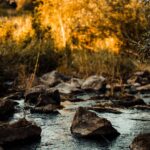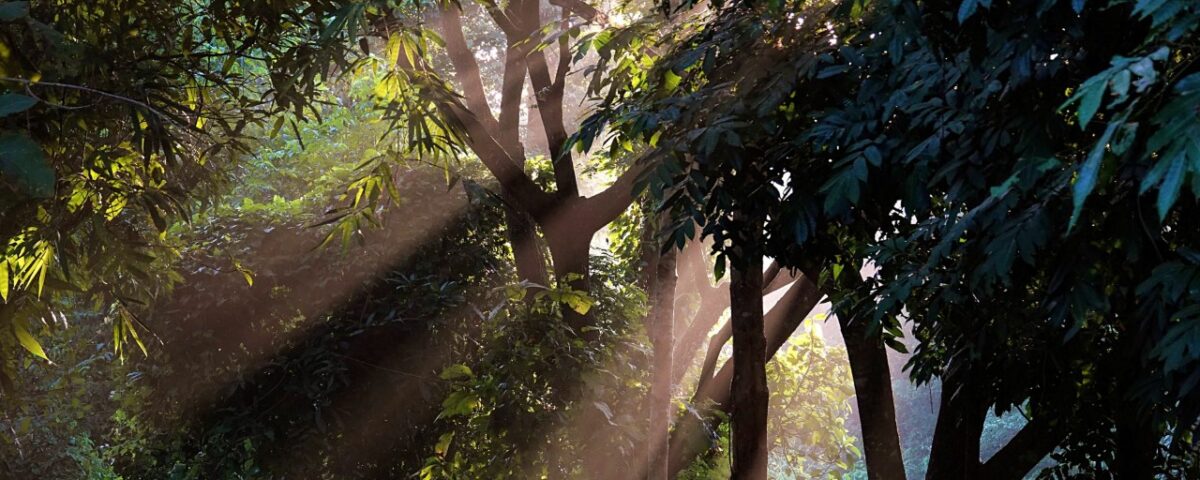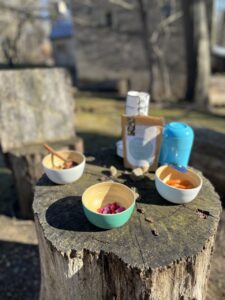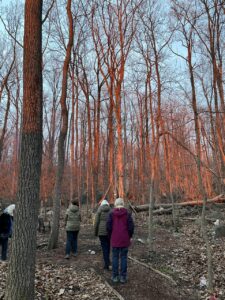
PRP Day 2023 Press Release

Prepping for Your PA Park Road Trip
By guest blogger, Erika Hovland Bahij
The words “parks and trails” may conjure up an image of Gore-tex-clad athletes hiking up steep hills with full backpacks and trail mix in hand. Scratch that image. The newest trend in visiting Pennsylvania Parks is accessible for people of all ages, abilities, and fitness levels.
Forest Therapy, also referred to as Forest Bathing or Shinrin-Yoku, is a practice in which people walk short distances, slowly, while engaging their senses to connect with the outdoors. Frequently guided by a certified Forest Therapy practitioner, participants generally slowly walk a mile or less.
What is the experience of Forest Therapy like?:
The perspective of Certified Forest Therapy Guide
When we pause to reflect, we create meaning from what we see and experience. Our ancestors—before electricity, smartphones and 24/7 streaming services—spent time gazing at stars or dipping their toes into fresh water. There is still something inside many of us that yearns for that visceral connection and to make meaning of our experiences. What would happen if we allowed the forest, or a tree, or a flower, to guide us into remembering our connection with nature?
The practice of Forest Therapy is grounded in the belief that the earth has wisdom to share with humans when we slow down long enough to pay attention. Because of this, I describe a Forest Therapy walk as more of a saunter than a hike. The root word of the verb “to saunter” means to muse or to wonder, and that’s what people do when they participate.
As a guide certified by the Association of Nature and Forest Therapy, I follow the practices of the organization, which views the forest as the “teacher” and the leader of the program as a “guide” who opens space for people to experience nature in the way that is meaningful for them. This means it’s hard to describe what an experience would be like for a particular individual. Generally speaking, however, many people talk about feeling more connected, more peaceful or describe the wonder of seeing something they had never seen before.
A typical guided program includes:
- an introduction to the walk
- a series of invitations (guided prompts or questions) to support you in connecting with nature during the program
- an ending sharing circle where participants gather, drink tea together and close the program.
We typically spend 1.5-3 hours exploring a natural setting, such as the woods, a park or arboretum.
The participants are supported by “invitations” which are prompts to notice the environment by engaging one or more senses. For example, a common invitation is to notice what is in motion around you. In one event, we paused to watch a squirrel leap from tree branch to tree branch while carrying leaves in her mouth, until she scurried into a hole high up in the tallest tree. We saw her tail twitch through the hole as she worked to build her nest. This sight may cause one person to think of squirrels in their home, another to wonder at the squirrel’s agility, and still another to feel they caught a glimpse into a previously-hidden world. Or, it may cause a person to make deeper meaning of their own life – wondering privately about their own leaping, clambering and foraging.
What benefit might I experience from Forest Therapy?
Forest therapy owes its roots in the Japanese practice of Shinrin-yoku. Surprisingly, the formal practice was established in the 1980s, after the government noticed a big increase in the incidence of cancer and autoimmune disease. They hypothesized that workers were spending more time inside working – perhaps overworking – and that these conditions negatively impacted their health. In response, the government sponsored research to figure out how to combat the health consequences. One of the questions they reinvestigated was “what happens when people spend time in forests?”
As you know, trees release oxygen, and we release carbon dioxide with our breath, which trees convert into food through photosynthesis. Excitingly, trees offer a benefit above and beyond this simple exchange.
Trees keep themselves healthy by releasing chemicals called phytoncides. These phytoncides seek out and kill fungus, so when a tree is attacked or invaded by an organism, it releases these chemicals. When we humans inhale phytoncides, our bodies begin to produce a special white blood cell, called a natural killer or NK-cell. NK-cells destroy cells that are stressed and could turn cancerous, so they work as a preventative measure to support our physical health. The Japanese saw this as an important finding and began to encourage people to go into the forest to “bathe” in phytoncides, which is why the practice is sometimes called forest bathing. Additionally, spending time in nature can help restore the ability to focus and pay attention – especially in people who have recently exerted significant mental energy at work or after studying.
Other benefits include lowered stress levels, lowered blood pressure and a boost of positive emotions, like peace, joy, and wonder,
How can I try Forest Therapy?
First, you may want to try a simple practice on your own. Visit a local park, sit beneath a tree and watch what happens around you. Ideally, spend 20 minutes just observing. If you can do it, you will usually be rewarded because more birds or animals will sense they can trust you and come into your line of vision.
However, “sit spot” can be challenging because it’s incredibly tempting to pull out the phone and start “doing” instead of just “being.”
This is why it can be helpful to have a guide offering prompts and gentle reminders to engage your senses. We help you slow down, so you can be fully present in the moment. We can also support you in feeling comfortable exploring a new park or unfamiliar trail, making it easier for families, those with physical limitations or people who feel a bit apprehensive of “the woods” to connect with nature. Guides are also certified in Wilderness First Aid, which provides another layer of safety for participants.
Many guides offer walks via Eventbrite or Facebook, or in partnership with local parks and preserves. Try searching “forest therapy near me.”
About the author
Erika Hovland Bahij is an award-winning entrepreneur and founder of Rose and Redwood LLC, which provides programs and products to nurture your true nature.® Programs such as Forest Therapy walks and Rose and Lion Leadership Programs for Children inspire people to connect to nature, unearth their strengths and feel inspired to share their gifts with the world. Certified through the Association of Nature and Forest Therapy (ANFT) as a Forest Therapy guide, Erika is also certified in Wilderness First Aid. She grew up in Minnesota (the land of 10,000 lakes!) and has spent many hours camping, hiking, and enjoying the outdoors. She now resides with her family in Pennsylvania. You can learn more about Erika here: https://roseandredwood.com







